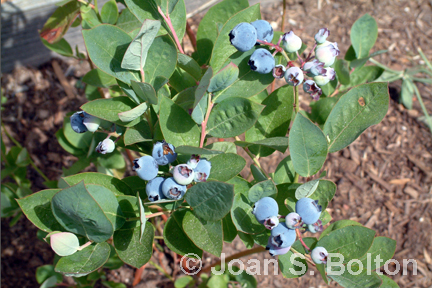
Blueberries are next to impossible to grow on the Central Coast, much less anywhere else in California, right?
That’s been the prevailing thought for years. After all, most blueberries are native to frigid, eastern climes, where they thrive in acidic forest duff.
But a wave of new varieties performs perfectly here. These new, southern highbush blueberries begin bearing fruit as early as February. Many peak in April and May. Some produce a few berries into September and October.
Along the coast, our mild temperatures mean that the fruit takes a little longer to ripen. But that’s a good thing, because the extra time helps boost the berries’ full-bodied flavor. And for the health conscious, blueberries are a terrific source of antioxidants.
Getting Started
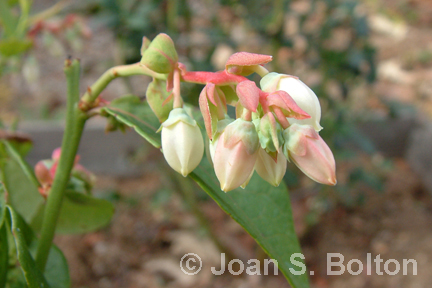
Like many deciduous fruit trees, traditional highbush blueberry bushes require freezing temperatures over winter.
However, the new southern varieties need little or no winter chill before breaking dormancy in spring. Indeed, some of the bushes are barely deciduous. They may even flower and fruit through late fall and winter, although winter temperatures may not be warm enough to fully ripen the fruit.
So provided you buy southern highbush varieties, you’re halfway there.
The other part of the equation is acidic soil that drains well. That’s where you’ll have to put in some effort.
First, plan to grow your blueberries in raised beds, mounds, large containers or half-whiskey barrels. Along the coast, plant in full sun. In inland valleys, a little shade is okay.
Next, acidify the soil. Most ordinary Central Coast soil leans toward alkaline, with pH levels ranging from 6.5 to 7.5. Blueberries perform best with a pH of 5 or less, so you’ll need to add quite a bit of acidic material.
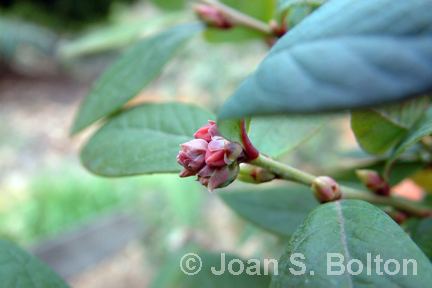
In the ground, dig a hole at least 2 feet wide and 1 foot deep. Mix half the soil with a comparable amount of peat moss and a handful of elemental sulfur. Set your bush or bare-root plant in the hole. To allow for settling, adjust the height so that the soil line on the trunk is an inch higher than the surrounding soil. Fill the hole.
Space your remaining bushes 3 to 4 feet apart. Work more sulfur into the surrounding bed. Shape basins about 3 inches tall around each plant. Then fill the basins with 2 inches of compost, shredded pine or some other finely ground wood or loose, organic matter.
In a container, plant your blueberries in a blend of 1/3 peat moss, 1/3 azalea-camellia mix and 1/3 organic material, such as coconut coir or redwood compost.
You can squeeze up to four plants into a half whiskey barrel to save space. However, collectively, the four bushes won’t produce as many blueberries as they would spaced further apart out in the garden.
Stripping Fruit
Conventional advice says to prevent your bushes from bearing berries for the first one to three years.
The theory is that the bushes should direct their early efforts toward developing a sufficient root mass to support larger crops later on. By that measure, the plants hit peak production from five years on.
It does make sense to strip the buds if you plant your blueberries from bare root, because the little whips don’t have much of a root system their first year.
But if you buy your bushes already rooted in a container, you may also already be seeing flowering and even some fruit. Who has the discipline — or heart — to strip that bounty from the branches? I know I don’t.
Irrigation
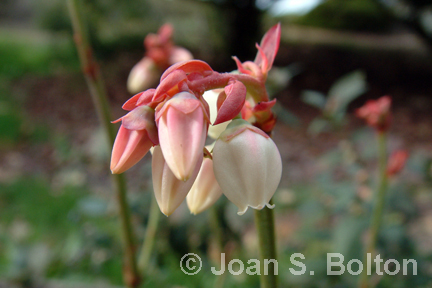
Blueberry bushes dry out easily, because most of their fibrous roots snake through the soil right below the surface. Their greatest need for water is from the time that the buds begin to form, through harvest. But they still need to be hydrated the rest of the year as well.
Water your bushes in the ground at least once a week. Containers tend to dry out faster, so water those bushes up to two to three times a week.
In either spot, that 2-inch layer of mulch will insulate the roots against drastic swings in moisture and temperature.
At the same time, beware that blueberry roots are susceptible to rot. That’s why the initial planting, in raised beds, mounds or containers, plus the serious amending of the soil, are so critical to your bushes’ long-term success.
Fertilizer
Wait until April to start fertilizing your plants. Then apply fertilizer every 2 months through fall. Use a humic acid-based product like GroPower Flower ‘N’ Bloom, any product designed for camellias and azaleas, or ammonium sulfate and iron chelate. Some folks swear by old coffee grounds.
Whether liquid or granular, spread the fertilizer throughout your blueberry patch. Thoroughly water it in. Don’t use a cultivator, which can damage the surface roots.
Replenish the mulch at least once a year. I add a layer of peat moss, too, to further acidify the soil.
Pruning
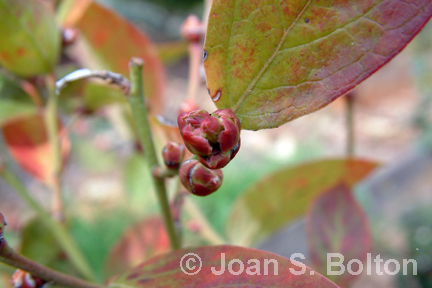
Blueberries don’t require much pruning. For the first few years, unless there’s an awkward, wayward branch, leave your bushes alone.
On older plants, the approach is similar to the initial steps taken when pruning a rose.
In late summer, after fruiting is over, cut down to the base any canes that are diseased, dying or are no longer producing. Remove any that rub up against younger, more promising growth, as well as any that cross back through or crowd the center of the bush. Also cut off any sucker growth that emerges from the soil away from the base of the plant.
If by then you’ve removed quite a bit of wood, you’re done.
Otherwise, if the branches still appear crowded, cut out a few older canes to balance the overall shape and to encourage air to move through the center. Blueberries produce on year-old wood, so be sure to leave several larger, new shoots, evenly spaced around the bush, to produce next year’s fruit.
Southern Highbush Blueberries — Choose Wisely
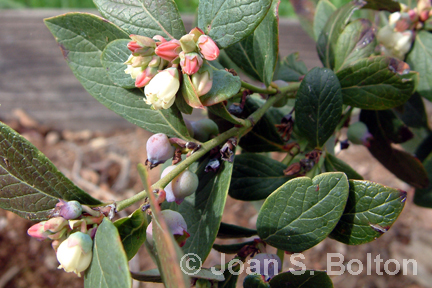
A single blueberry bush will hardly satisfy the hunger of one person, much less an entire household. Instead, plan to grow at least two or three bushes.
Select several varieties. While blueberries don’t insist on a companion type to bear fruit, they will bear more heavily if they have the opportunity to cross-pollinate.
By growing varieties that fruit at different times, you’ll extend the harvest as well.
Try the following:
• Jubilee. Mid-season. Light-green foliage and sweet, sky-blue fruit. Upright, compact growth to 6 feet tall. Leaves turn olive green and bronze in fall.
• Misty. Early. Bright, blue-green foliage and sky-blue fruit. Vigorous, slightly spreading growth to 6 feet tall. Evergreen in my garden.
• O’Neal. Very early. Large, juicy, purple-blue fruit. Upright, spreading growth to 4 to 6 feet tall. Leaves turn orange and wine in fall.
• Sharpblue. Early and nearly ever-bearing. Medium-sized, abundant, gray-blue fruit. Upright and spreading growth to 5 to 6 feet tall. Evergreen.
• Sunshine Blue. Mid-season. Hot-pink flowers, followed by dark-blue fruit. Compact growth to 3 feet tall. Evergreen.
Seeds of Wisdom
Blueberries will be at their sweetest just before they’re ready to fall off. Net your bushes to prevent marauding birds from devouring your precious crop.
≈
Copyright, Joan S. Bolton. All rights reserved. Reproduction of text or photos in any form is prohibited without written permission.
≈
